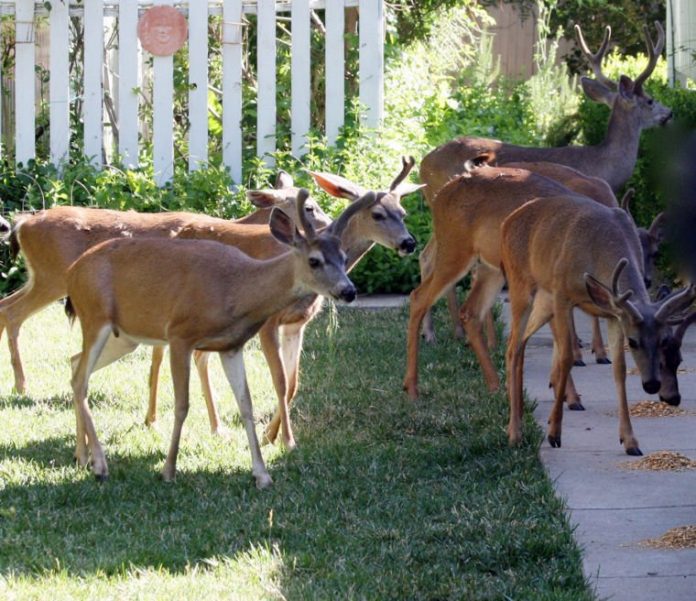BECAUSE Santa travels by flying through the sky and landing on roofs, you’re not likely to come into contact with Rudolph or his fellow reindeer while driving home from work or a holiday party. But, you DO need to drive cautiously to avoid their cousins, black-tailed deer, which are often to be found crossing local roads during deer breeding and migrating season (October to December). Even in the daytime, they can be found close to our suburban developments, browsing on acorns, berries, fungi, grasses, sage, lichen, nuts, and shrubs and varying their diet with garden plants and tree fruit. The black-tails, a subspecies of mule deer, prefer mixed habitat with both open areas for feeding and forest or brushy areas for protection. The south Bay Area provides them such a prime habitat, such as at Anderson Lake where this deer was seen.
However, an increasing deer population and displacement of deer habitat caused by the drought and urban sprawl are producing ever more hazardous conditions for motorists and deer. There are over 100,000 deer-and-vehicle collisions reported each month in the United States. A few safety reminders may help prevent this tragic occurrence:
1. Slow down!
2. Deer are most active at night between 6 and 9 p.m.
3. Be aware of your surroundings. Watch for posted deer crossing signs.
4. Use high beam headlights as much as possible at night.
5. Deer usually travel in herds—if you see one, it’s likely that more are following.
6. If a collision seems inevitable, don’t swerve to avoid the animal. Hitting oncoming traffic could be even worse. Be prepared to brake hard.
If you do hit a deer, DO NOT attempt to move or rescue the deer yourself. They are very dangerous animals. Call 911 to report the accident. By driving carefully at night, you may also save the lives of other nocturnal animals, such as mountain lions, raccoons, opossums, and coyotes that could be out looking for food or a mate.
Though the Wildlife Education and Rehabilitation Center does not admit deer for rehabilitation, we do offer advice on orphaned fawns. (Sick or injured adults require special California permits for rehabilitation.) During spring and summer months, people come across fawns that are lying still and quiet in the woods and ask us for help. We advise that most likely the fawn has its mother close by, on the alert for intruders. To avoid attracting predators to where the vulnerable babies are hidden, mother deer hide their young in the grass and come by to feed them when it’s safe. The doe may only return twice a day to nurse her young. These “home alone” animals are not abandoned and should be left in place. If they have been “rescued”, they need to be returned to where they were found as quickly as possible. Contact your local wildlife rehabilitation center for complete instructions on safe return techniques.
All are invited to a WERC event. Morgan Hill artist Evelyn Davis, a former WERC wildlife volunteer will be unveiling and dedicating the installation of “Dear Family”, her life-size bronze sculptures of a black-tailed deer family on Friday, December 18th at 3 pm. The sculptures will be installed on the median near 3rd and Monterey Streets, in downtown Morgan Hill. Not far away, at the Centennial Recreation Center, you can also check out Ms. Davis’s 2006 sculpture of “Liberty”, a young bobcat that she helped rehabilitate at WERC and released. Ms. Davis’s artwork exemplifies her long-time commitment to encouraging peaceful coexistence between civilization and our native wildlife. For more information visit we**@*****ca.org















